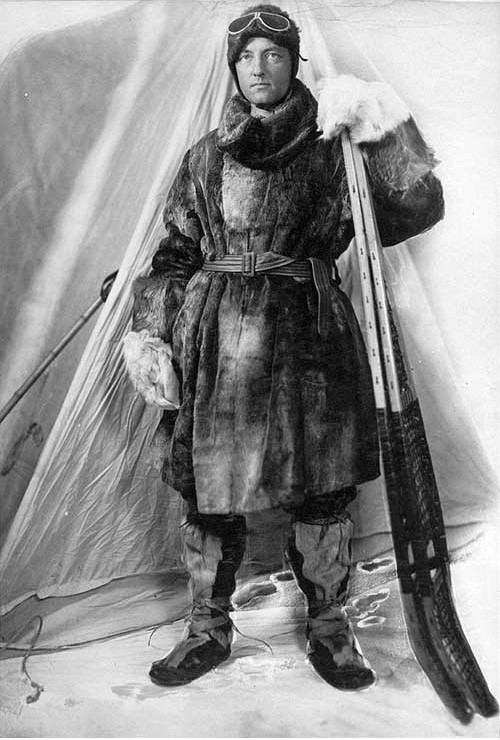85 Years Ago—Jan. 12, 1940: US Interior Department motorship North Star reaches Bay of Whales, Antarctica, to establish West Base for expedition under Adm. Richard Byrd.

Commander Richard E. Byrd in Arctic Garb, with snowshoes, circa 1929–1930. Original caption reads, “Commander Richard E. Byrd, who is undertaking the coming expedition to the Antarctic Region. This will be the most scientific expedition ever attempted. Byrd will fly over the South Pole. Official U.S. Navy Photograph, National Archives collection. Catalog 306-NT-549A-3.
Antarctic Arrival

On January 12, 1940, the North Star was the first of the fleet of ships to sail into the Bay of Whales. Its valuable cargo seemed to have made the trip just fine. Hopes were high that the cruiser was now ready to accomplish all the team planned for it
Location of Bay of Whales
But reality set in quickly. A ramp was built so that the vehicle could roll off the ship and onto the ice. As it traveled across the ramp, the wood holding the ramp crunched on cue as the gigantic conveyance rolled over each section. Fortunately, the cruiser was not damaged in the process.
However, after that, the cruiser never really achieved its potential. They gave up trying to use it for travel and were able to make it function well as a work base. Even with the exterior temperatures hovering in the range of – 50 degrees, life inside the cruiser was roomy and comfortable.
War Looms
As it became clear the United States was likely to get involved in the war, Admiral Byrd and his team realized they needed to return to the United States. There was nothing to do but leave the snow cruiser there.
Dr. Poulter was regretful, but he made notes about how the cruiser could be fixed to make it operational. He intended to return when he could to get the thing going again.
The Pullman-built snow cruiser was left parked near Little America III on December 22, 1940. No one realized that was the official good-bye.
After the War
By the time the war ended, it took time to get an expedition going for a return to Antarctica.
There were dreams that somehow the cruiser could be re-tooled, but when the men located it in 1946, they saw that it was a lost cause. The changes in technology during the war were so vast that there was little enthusiasm for doing anything with the snow cruiser.

Snow cruiser buried in snow drifts.
The next sighting of the cruiser was when an Antarctic team arrived in 1958 and several bamboo poles rising above snow. They suspected that was where the vehicle was and decided to excavate to see if anything of value was inside.
Using a bulldozer to dig through many feet of snow, they were able to step into the living quarters. Everything was perfectly preserved—from newspapers and magazines to left-behind cigarettes.
Wisdom Ignored
In 1939, The Boston Globe ran an article citing an interview with a man the reporter identified as the “glacier priest.” Reverend Bernard R. Hubbard, told the reporter: “With all the difficulty it had in crossing the magnificent highway system of the United States, I fear that when it gets into the insurmountable difficulties of higher glacial altitudes, it may not quite live up to expectations.”
But Reverend Hubbard added a footnote: “If the snow cruiser holds up in the ice fields, it will be one of the greatest mechanical successes ever achieved in polar regions.”
Clearly, the scientists had staked their hopes on the footnote.
Where is the Antarctic Snow Cruiser Now?
Today no one is sure what has happened to (the) Byrd snow cruiser built by the Pullman train company. In the mid-1960s, a large portion of the Ross Ice Shelf fell into the Southern Ocean, carrying with it much of Little America. In all likelihood, Admiral Byrd’s snow cruiser fell with it, an underwater symbol of well-intentioned hopes and dreams.
This was quoted from: Antarctic Snow Cruiser by Pullman – America Comes Alive
Many years later, Byrd was able to convince the Secretary of the Navy as well as that of the Chief of Naval Operations, Fleet Admiral Chester W. Nimitz, that an enormous naval operation, later titled the UNITED STATES NAVY ANTARCTIC DEVELOPMENTS PROGRAM 1946-47, was much needed. It became better known as OPERATION HIGHJUMP. You can search your heart out on this one all over the internet. In fact, just wait for my trilogy (and sequel) to read how his fictional great grand-daughter followed in his footsteps with her personal jet flying through the South Pole entrance to prove his theories that were hushed up by the U.S. Government. My books, The Adventures of Patience A. Byrd in Hollow Earth, were based on true facts concerning Rear Adm. Richard E. Byrd when he traveled beneath the ice in the Antarctic. The trilogy will be published soon. (Fingers crossed.)
